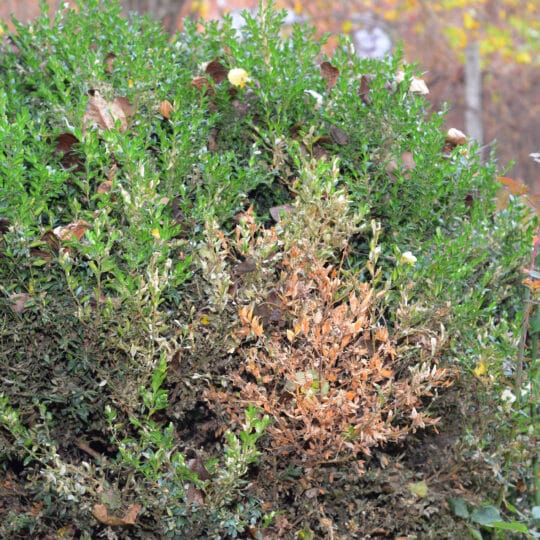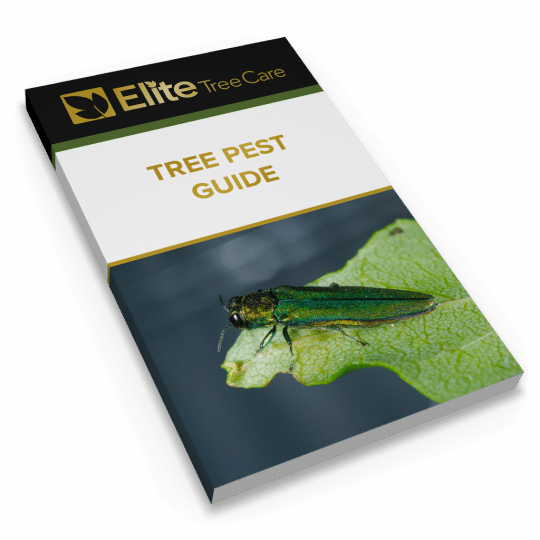Why are My Boxwoods Buzzing?
Identifying Boxwood Leafminer Pests
Posted
March 21, 2024

If you listen closely to your plants, some may tell you there’s a problem that needs addressing. Take the beautiful evergreen boxwood. If you hear a happen to hear a light buzzing or snapping sound coming from the leaves, that could be a sign of trouble. The boxwood leafminer is a common pest to this particular shrub. Learn how to identify and treat the problem before it takes over.
Signs of a Boxwood Leafminer
There are several ways to tell if pests are attacking your plants. Since boxwood leafminers suck out the juicy green tissue in between the leaves, this is where you’ll notice the most action. Plus, this particular pest can be seen and heard.
- Crackling sound. An early sign of leafminers are the sound of pupae chewing their way through the leaves. This sound only occurs for a week or two in early spring.
- Orange-tinted leaves or pale light green or yellow specks. These leaves are currently being eaten.
- Brown, blistered leaves. These leaves have already been mined by the pupae.
- Small yellow larvae. If you hear the leaves crackling or see the early signs of damage, divide the leaf and look for this culprit.
- Small orange flies. Adult leafminers look like tiny mosquitoes. While they don’t feed on blood, they do fly around for a short period while breeding and laying eggs. In the middle of the spring, you can see them swarming in a cloud of tiny flies around the infected plants.
Luckily, boxwood leafminers are picky about what plants they like. Unfortunately, it’s almost all species of boxwoods. There are a few types that are more resistant to pests. If you’re looking to plant new boxwood or replace heavily damaged plants, look for a resistant variety.
Treating an Infected Boxwood
Once you’ve determined you have a boxwood leafminer problem, there are several treatment options.
- Pruning. This method takes expert timing. Once you see the blistered leaves or hear the cracking in the early spring, prune as many blistered branches as you can. Once the sound stops, it means the flies have emerged and already started breeding. You can also prune late in the spring after the adults have laid eggs. Trim off about six inches of the outer leaves, where most of the eggs will be. Be sure to dispose of these clipping properly and disinfect the shears to prevent spreading.
- Sticky cards. If you missed the early spring window and don’t want to wait till late spring for pruning, you can use yellow sticky cards to catch the flies before they lay their eggs in the middle of spring. Stake the cards about six inches above the shrubs. Leafminers will be attracted to the bright color and get trapped on the surface. Dispose the cards once the two-week breeding window is over.
- Beneficial insects. Sometimes attracting other insects can help rid your garden of the pests you don’t want. Spiders can lend eight helping hands by catching leafminer flies within the web. Dragon flies and praying mantis are also two species who feed on the leafminers. You can attract these beneficial bugs by also growing flowering plants in your garden near the boxwoods.
There are insecticides for these types of pests, but like any chemical solution, they can harm beneficial garden bugs, especially pollinators. This is why pruning and non-chemical methods are a more eco-friendly solution.
Pest Prevention
Another way to help rid your yard of pests is by regularly maintaining the surrounding area. From the grass to the tallest tree, properly pruning, watering, and fertilizing can promote healthy growth. Since most pests are more attracted to weak and decaying plants, boosting the health and vitality of your yard is a win-win for you and your garden.
If you’re looking for help with proper pruning of your trees and shrubs, call the specialists at Elite Tree Care. Not only can we help you shape your plants for optimal growth, but the right pruning can mean the difference between an infected plant and a thriving one.

Download Your FREE Tree Pest Guide
Use our guide to identify some of the most common tree pests and how to protect your trees from their damage.